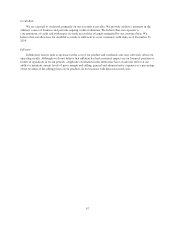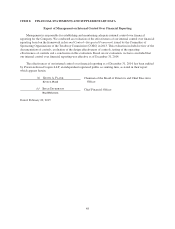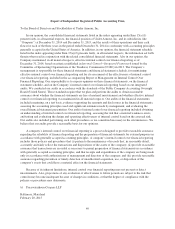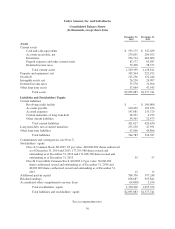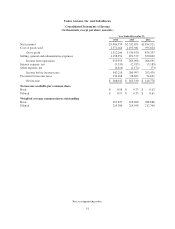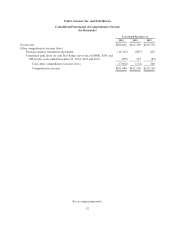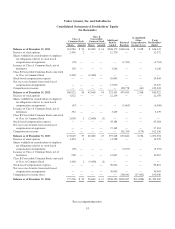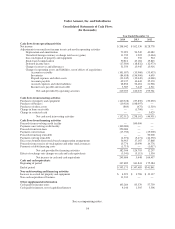Under Armour 2014 Annual Report Download - page 67
Download and view the complete annual report
Please find page 67 of the 2014 Under Armour annual report below. You can navigate through the pages in the report by either clicking on the pages listed below, or by using the keyword search tool below to find specific information within the annual report.Goodwill, Intangible Assets and Long-Lived Asset
s
Goodwill and intangible assets are recorded at their estimated fair values at the date of acquisition and ar
e
allocated to the reporting units that are expected to receive the related benefits. Goodwill and indefinite lived
intangible assets are not amortized and are required to be tested for impairment at least annually or sooner
whenever events or changes in circumstances indicate that the assets may be impaired. In conducting an annual
impairment test, the Company first reviews qualitative factors to determine whether it is more likely than not tha
t
the fair value of the reporting unit is less than its carrying amount. If factors indicate that is the case, the
Company performs a quantitative assessment over relevant reporting units, analyzing the expected present valu
e
o
f future cash flows and quantify the amount of impairment, if any. The Company performs its annual
impairment tests in the fourth quarter of each fiscal year.
The Company continually evaluates whether events and circumstances have occurred that indicate th
e
r
emaining estimated useful life of long-lived assets may warrant revision or that the remaining balance may not
be recoverable. These factors may include a significant deterioration of operating results, changes in busines
s
p
lans, or changes in anticipated cash flows. When factors indicate that an asset should be evaluated for possible
impairment, the Company reviews long-lived assets to assess recoverability from future operations usin
g
undiscounted cash flows. If future undiscounted cash flows are less than the carrying value, an impairment is
r
ecognized in earnings to the extent that the carrying value exceeds fair value.
Accrued Ex
p
enses
A
t December 31, 2014, accrued expenses primarily included
$
61.4 million and
$
14.0 million of accrued
compensation and benefits and marketing expenses, respectively. At December 31, 2013, accrued expenses
p
rimarily included
$
56.7 million and
$
11.9 million of accrued compensation and benefits and marketing
expenses, respectively
.
F
oreign Currency Translation and Transactions
The functional currency for each of the Company’s wholly owned foreign subsidiaries is generally th
e
applicable local currency. The translation of foreign currencies into U.S. dollars is performed for assets an
d
liabilities using current foreign currency exchange rates in effect at the balance sheet date and for revenue an
d
expense accounts using average foreign currency exchange rates during the period. Capital accounts are
translated at historical foreign currency exchange rates. Translation gains and losses are included in stockholders’
equity as a component of accumulated other comprehensive income. Adjustments that arise from foreign
currency exchange rate changes on transactions, primarily driven by intercompany transactions, denominated in
a
currency other than the functional currency are included in other expense, net on the consolidated statements of
income.
Derivatives and Hedging Activities
The Company uses derivative financial instruments in the form of foreign currency forward and interest rat
e
swap contracts to minimize the risk associated with foreign currency exchange rate and interest rate fluctuations.
T
he Company accounts for derivative financial instruments pursuant to applicable accounting guidance. Thi
s
guidance establishes accounting and reporting standards for derivative financial instruments and requires all
derivatives to be recognized as either assets or liabilities on the balance sheet and to be measured at fair value
.
U
nrealized derivative gain positions are recorded as other current assets or other long term assets, and unrealized
derivative loss positions are recorded as accrued expenses or other long term liabilities, depending on th
e
derivative financial instrument’s maturity date
.
5
7


